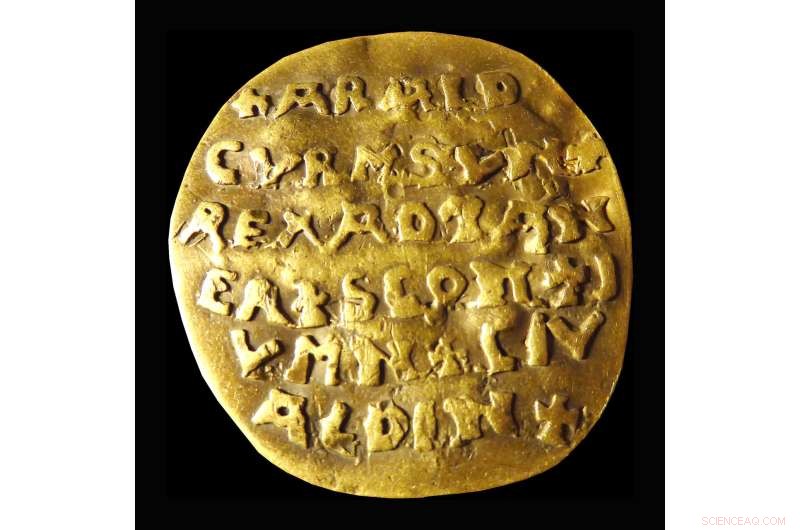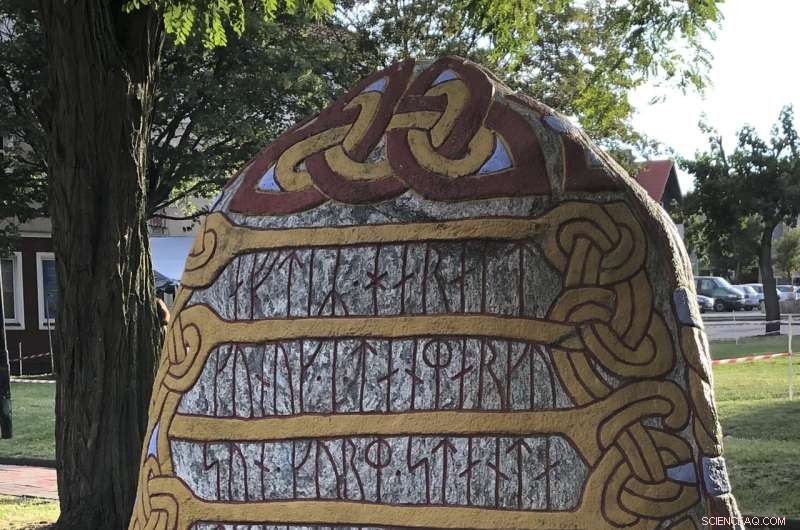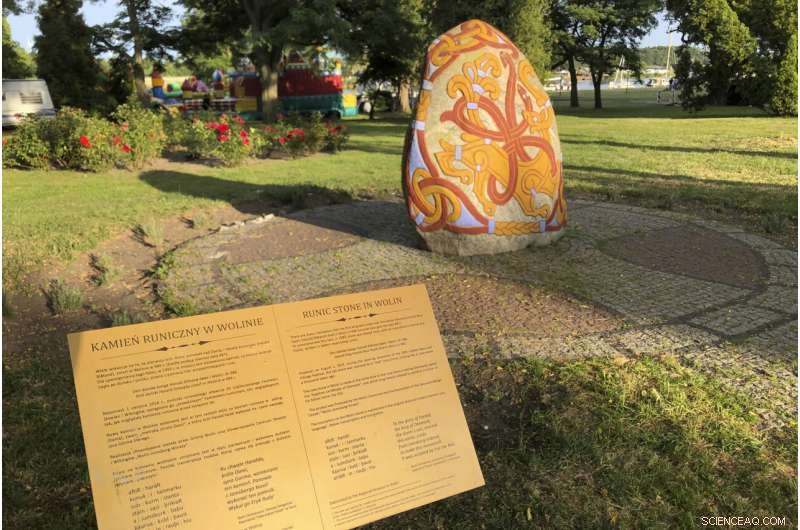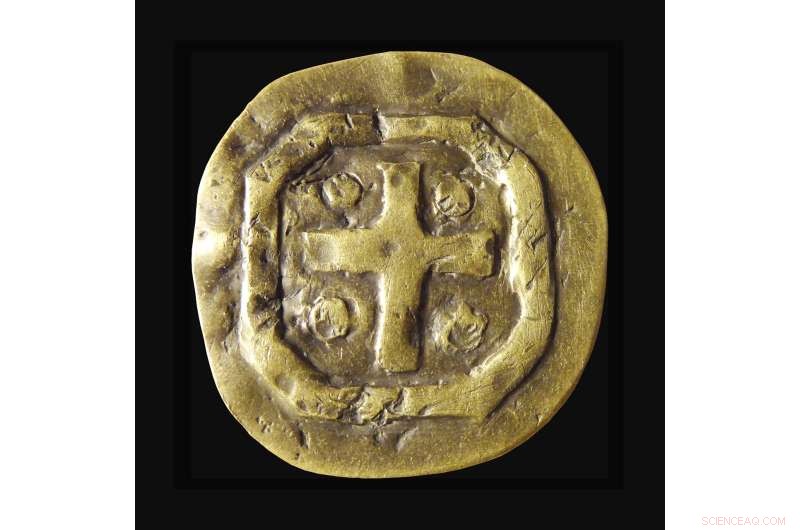
Le disque doré Curmsun du 10ème siècle portant le nom du roi danois Harald "Bluetooth" Gormsson (Curmsun en latin), provenant d'une tombe de l'église catholique romaine de Wiejkowo, en Pologne, photographié à Malmö, en Suède, en 2015. Le Bluetooth la technologie de liaison sans fil porte le nom du roi. Plus de 1 000 ans après sa mort dans l'actuelle Pologne, un roi danois dont le surnom est connu du monde entier grâce à la technologie Bluetooth est au centre d'une dispute archéologique. Crédit :Sven Rosborn via AP
Plus de 1 000 ans après sa mort dans l'actuelle Pologne, un roi européen dont le surnom perdure grâce à la technologie sans fil est au centre d'un différend archéologique.
Les chroniques du Moyen Âge disent que le roi Harald "Bluetooth" Gormsson du Danemark a acquis son surnom grâce à une dent, probablement morte, qui avait l'air bleutée. Une chronique de l'époque indique également que le roi viking a été enterré à Roskilde, au Danemark, à la fin du Xe siècle.
Mais un archéologue suédois et un chercheur polonais ont récemment affirmé dans des publications distinctes qu'ils avaient identifié son lieu de sépulture le plus probable dans le village de Wiejkowo, dans une région du nord-ouest de la Pologne qui avait des liens avec les Vikings à l'époque d'Harald.
Marek Kryda, auteur du livre "Viking Poland", a déclaré à l'Associated Press qu'un "monticule païen" qu'il prétend avoir situé sous l'église catholique romaine du XIXe siècle de Wiejkowo abrite probablement les restes du roi. Kryda a déclaré que des images satellites géologiques disponibles sur un portail du gouvernement polonais ont révélé une forme ronde qui ressemblait à un tumulus viking.
Mais l'archéologue suédois Sven Rosborn, dit que Kryda a tort parce que Harald, qui s'est converti du paganisme au christianisme et a fondé des églises dans la région, a dû recevoir une tombe appropriée quelque part dans le cimetière. L'église de l'Immaculée Conception de la Bienheureuse Vierge Marie de Wiejkowo se dresse au sommet d'une petite colline ronde.

Une vue d'une pierre de 2014 avec une inscription runique à la mémoire du roi danois Harald "Bluetooth" Gormsson du Xe siècle, à Wolin, en Pologne, le samedi 30 juillet 2022. Plus de 1 000 ans après sa mort dans l'actuelle Pologne, un roi danois dont le surnom est connu du monde entier grâce à la technologie Bluetooth est au centre d'une dispute archéologique. Un chercheur polonais et un archéologue suédois affirment avoir identifié le lieu de sépulture probable du roi Harald Bluetooth Gormsson dans un petit village du nord-ouest de la Pologne, une région qui avait autrefois des liens avec les Vikings. Crédit :AP Photo Monika Scislowska
Les historiens du Musée national danois de Copenhague disent être familiers avec la "suggestion" selon laquelle Wiejkowo est le lieu de sépulture de Harald.
Rosborn a détaillé ses recherches dans le livre de 2021 "The Viking King's Golden Treasure" et Kryda a contesté certaines des découvertes du Suédois dans son propre livre publié cette année.
Harald, who died in 985, probably in Jomsborg—which is believed to be the Polish town of Wolin now—was one of the last Viking kings to rule over what is now Denmark, northern Germany, and parts of Sweden and Norway. He spread Christianity in his kingdom.
Swedish telecommunications company Ericsson named its Bluetooth wireless link technology after the king, reflecting how he united much of Scandinavia during his lifetime. The logo for the technology is designed from the Scandinavian runic letters for the king's initials, HB.

A view of a 2014 stone with runic inscription in memory of Danish 10th century King Harald “Bluetooth” Gormsson, in Wolin, Poland, Saturday, July 30,2022. More than 1,000 years after his death in what is now Poland, a Danish king whose nickname is known to the world through the Bluetooth technology is at the center of an archeological dispute. A Polish researcher and a Swedish archeologist claim that they have pinpointed the probable burial site for King Harald Bluetooth Gormsson in a small village in northwestern Poland, an area that once had ties with the Vikings. Credit:AP Photo Monika Scislowska
Rosborn, the former director of Sweden's Malmo City Museum, was spurred on his quest in 2014 when an 11-year-old girl sought his opinion about a small, soiled coin-like object with old-looking text that had been in her family's possession for decades.
Experts have determined that the cast gold disk that sparked Maja Sielski's curiosity dated from the 10th century. The Latin inscription on what is now known as the "Curmsun disk" says:"Harald Gormsson (Curmsun in Latin) king of Danes, Scania, Jomsborg, town Aldinburg."
Sielski's family, who moved to Sweden from Poland in 1986, said the disk came from a trove found in 1841 in a tomb underneath the Wiejkowo church, which replaced a medieval chapel.
The Sielski family came into the possession of the disk, along with the Wiejkowo parish archives that contained medieval parchment chronicles in Latin, in 1945 as the former German area was becoming part of Poland as a result of World War II.

The Roman Catholic church where it is believed that Danish King Harald Gormsson was buried, in Wiejkowo, Poland, Saturday, July 30, 2022. More than 1,000 years after his death in what is now Poland, a Danish king whose nickname is known to the world through the Bluetooth technology is at the center of an archeological dispute. A Polish researcher and a Swedish archeologist claim that they have pinpointed the probable burial site for King Harald Bluetooth Gormsson in a small village in northwestern Poland, an area that once had ties with the Vikings. Credit:AP Photo Monika Scislowska

A view inside the Roman Catholic church where it is believed that Danish King Harald Gormsson was buried, in Wiejkowo, Poland, Saturday, July 30, 2022. More than 1,000 years after his death in what is now Poland, a Danish king whose nickname is known to the world through the Bluetooth technology is at the center of an archeological dispute. A Polish researcher and a Swedish archeologist claim that they have pinpointed the probable burial site for King Harald Bluetooth Gormsson in a small village in northwestern Poland, an area that once had ties with the Vikings. Credit:AP Photo Monika Scislowska

The 10th century golden Curmsun disc with the name of Danish King Harald “Bluetooth“ Gormsson (Curmsun in Latin) on it, coming from a tomb at the Roman Catholic church in Wiejkowo, Poland, photographed in Malmo, Sweden, in 2015. The Bluetooth wireless link technology is named after the king. More than 1,000 years after his death in what is now Poland, a Danish king whose nickname is known to the world through the Bluetooth technology is at the center of an archeological dispute. Credit:Sven Rosborn via AP
A family member who knew Latin understood the value of the chronicles—which dated as far back as the 10th century—and translated some of them into Polish. They mention Harald, another fact linking the Wiejkowo church to him.
The nearby Baltic Sea island and town of Wolin cultivates the region's Viking history:it has a runic stone in honor of Harald Bluetooth and holds annual festivals of Slavs and Vikings.
Kryda says the Curmsun disk is "phenomenal" with its meaningful inscription and insists that it would be worth it to examine Wiejkowo as Harald's burial place, but there are no current plans for any excavations.
© 2022 L'Associated Press. Tous les droits sont réservés. Ce matériel ne peut être publié, diffusé, réécrit ou redistribué sans autorisation. Archaeologists find silver treasure on German Baltic island